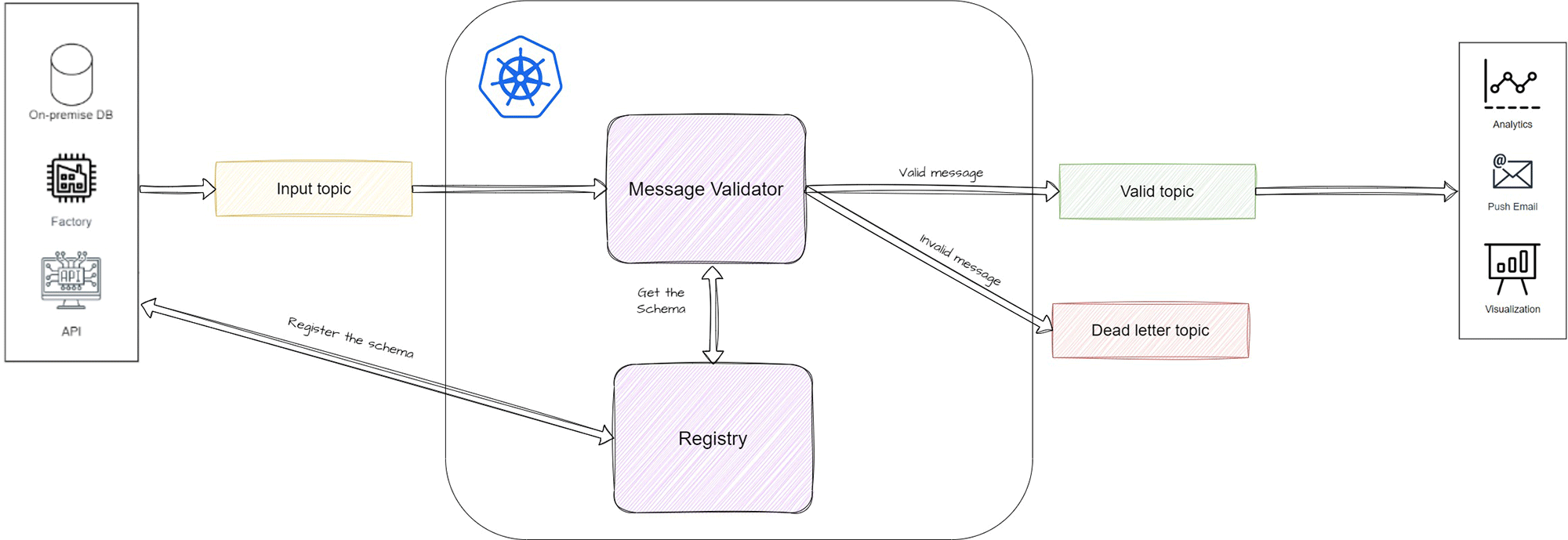
Robert Dakovic, Nikola Tomazin
DATA ENGINEERS
Introduction
In the rapidly evolving landscape of modern business, data reigns supreme. Whether you’re a tech giant, a burgeoning startup, or anything in between, your organization relies on data to make informed decisions, fuel innovation, and drive growth. But as data volumes soar and complexity mounts, maintaining the integrity and consistency of your data can become a daunting challenge. Inconsistent data formats and inadequate governance can expose your business to security breaches, compliance violations, and reputational damage.
New attributes are generated by your data producers on a regular basis. Think of how regularly the apps on your phone need an update. All these updates mean that new data attributes become available to the data platforms behind those apps. This is a good thing, as more data means more insights and more ways to make better business decisions. Getting those new attributes ready for processing on your platform is crucial because by ignoring them you could lose valuable time and in a worst-case scenario even a lot of money.
Enter the Dataphos Schema Registry – middleware that can revolutionize the way your business handles data. In this blog, we will delve into the critical importance of the Dataphos Schema Registry for businesses of all sizes and industries, emphasizing their profound impact on addressing business needs and reaping a multitude of benefits.
Having the Dataphos Schema Registry can fill in these business needs:
- Data Consistency: Inconsistencies in data formats can lead to chaos within an organization. The schema registry provides a centralized repository for data schemas, ensuring that all data producers and consumers adhere to the same standards, fostering better collaboration and more accurate decision-making.
- Compatibility and Validity: In our commitment to data quality, we address a critical dimension by actively validating data, and safeguarding against the ‘garbage in, garbage out’ phenomenon. We ensure that foul data is meticulously filtered, preventing it from interfering with downstream consumers. By upholding compatibility and validity through our schema registry, we prioritize the delivery of accurate and dependable data, minimizing the risk of unreliable outcomes.
- Faster Development and Integration: As your business grows, integrating new data sources and applications becomes more complex. The Schema Registry streamlines this process by acting as a reference point for data structures and allows for automatic schema evolution, leading to uninterrupted business processes. This accelerates development cycles, reduces integration headaches, and allows you to bring new products and features to market faster.
Our Solution
Dataphos Schema Registry is a cloud-based schema management and message validation system.
Schema management consists of schema registration and versioning which allows developers schema standardization across the organization, and message validation consists of validators that validate messages for the given message schema. Its core components are a server with an HTTP RESTful interface that is used to manage and access the schemas and lightweight message validators.
The Message Validator ensures that your data stays in perfect shape. It actively validates every piece of data against its schema and swiftly directs valid data to its intended destination and flags any anomalies to a designated area (Dead-letter topic). This meticulous approach guarantees pristine data quality throughout your organization.
A high-level overview of the Dataphos Schema Registry
How it works:
- The source systems create a schema (either automated or manually) and register it in the Schema Registry from which they receive an ID and Version.
- The source systems produce data in a particular format, such as Avro, JSON, ProtoBuf, CSV, or XML. Before producing data, they insert the ID and Version received in the previous step in the message metadata.
- When the data gets ingested by the streaming pipeline, it is actively validated against the schema definition to ensure that it conforms to the expected structure and data types.
- Depending on the validation result, the data will be either sent to the valid topic, where the consumers are subscribed, or to the dead-letter topic, where the invalid data will reside and wait for manual inspection.
Message processing
By using the Schema Registry to manage the schemas for the data, you can ensure that the data flowing through the pipeline is well-formed and compatible with all the downstream systems, reducing the likelihood of data quality issues and system failures, without affecting the overall throughput. Additionally, by providing a central location for schema definitions, you can improve collaboration and communication between teams working with the same data.
How can Dataphos Schema Registry Help You in Your Industry?
Companies often find themselves juggling data from various sources, constantly evolving and changing. This can lead to data chaos, making it challenging for your teams to extract valuable insights.
But here’s where Schema Registry truly shines – we understand the complexities of a constantly shifting data landscape. Companies frequently update their data producers, which can disrupt the entire data ecosystem. We are here to provide the solution. With Schema Registry, you’ll establish a consistent process for updating schemas, ensuring that producers and consumers truly align with each other.
Our event-driven system ensures that every change in your data producers integrates with your client systems. It empowers your consumers with the knowledge they need to confidently interpret incoming data, resulting in a more agile and responsive organization. Here is a comprehensive list of Schema Registry use cases:
- Streamlined Data Integration: Simplify the process of integrating data from diverse sources with a unified schema, reducing the time and effort required to make data from different systems coherently work together. This results in the consumer not having to worry if it will crash upon referencing a removed attribute from an older version of the schema that the producer updated without notifying the rest of the system. Additionally, a schema registry can help detect schema incompatibilities early on, preventing costly failures downstream as systems evolve over time.
- Efficient Data Warehousing: Ensure data accuracy and consistency when ETL processes feed data into data warehouses, minimizing data transformation errors and improving the reliability of analytics and reporting without affecting performance.
- Consistent Data Migration: Facilitate smooth data migration between systems by enforcing predefined schemas, mitigating the risk of data loss or corruption during transitions.
- Data validation and governance: A schema registry can ensure that the data being produced and consumed by different systems conform to a specified schema. This helps ensure data quality and consistency across the organization, which is particularly important in regulated industries with stringent compliance requirements.
- Real-time Data Processing: Enable real-time data processing in streaming data platforms by guaranteeing that producers and consumers use compatible schemas, supporting timely data analysis and decision-making.
- Optimized IoT Insights: Improve IoT data interpretation and analysis by ensuring consistent data schemas, enabling real-time insights and actionable outcomes from sensor and device-generated data.
- Data Consistency in ML Pipelines: Maintain data lineage and schema consistency in machine learning pipelines, ensuring the quality and reliability of machine learning model inputs.
- Simplified Microservices Communication: Reduce integration complexities in microservices architectures by enforcing consistent and compatible data schemas, fostering seamless communication between services.
- Data discovery: A schema registry can be used to help data consumers discover and understand the structure of data available in the organization. By providing a central location for data schema definitions, a schema registry makes it easier for data analysts and engineers to find and understand the data they need.
Differentiation and Features
Schema Registry comes with many valuable features. Let’s take a closer look at those that set our product apart:
- Performance: Speed matters in data management. Even though it is a middleware, Schema Registry is engineered for high performance, enabling rapid data processing while minimizing any noticeable impact on latency, to deliver a seamless user experience.
- Compatibility and validity checks: Say goodbye to compatibility issues and invalid data. Our solution offers robust checks to ensure that your data schemas easily align with your systems.
- Cloud support: We understand that businesses operate across diverse cloud environments. Schema Registry is cloud agnostic. Designed with versatility in mind, it effortlessly integrates with Kubernetes, ensuring compatibility both in cloud deployments and on-premises setups.
- Data Mesh ready: Embrace the future of data with ease. Schema Registry is Data Mesh ready, allowing each team to have its dedicated message validator rather than relying on a centralized system.
- Alerting: When the schema changes or when a specified threshold of messages reaches the dead letter topic, our Schema Registry takes proactive measures by triggering email or Teams alerts. This ensures swift notification and allows teams to promptly address evolving schema structures or address potential issues indicated by the accumulation of messages in the dead letter topic.
- Wide range of message brokers and databases: Schema Registry works with a variety of message brokers (Apache Kafka, Google Pub/Sub, Azure ServiceBus, Azure EventHubs, and some less popular like NATS, Pulsar, etc.), providing compatibility with different platforms to meet diverse needs. Notably, it also supports protocol changes, allowing validation of messages from producers using one broker, such as Kafka, while facilitating the transmission of validated messages to a different broker, such as Pub/Sub. Moreover, the Schema Registry stores the schemas within various databases ranging from traditional solutions like PostgreSQL to cloud-specific databases like Firebase and Cosmos DB.
- Support for Multiple Data Formats: JSON, CSV, XML, Avro and Protobuf.
Results and Benefits
Cost-consciousness: Not having a centralized and structured schema repository causes data inconsistency because some producers update their schema without notifying the consumer, so the consumer lacks understanding of the data. Also, if there are schema compatibility requests, the messages’ new version might not be compatible with the previous one. These problems, and many others, result in the main system collecting data that either has to be thoroughly cleaned (costing time and money) in order to be processed, or unusable at all.
Risk aversion: When messages arrive directly from producers to consumers, the newly evolved schema version might be incompatible with the schema stored at the consumer, and that can cause the consumer to process the data incorrectly. For example, the consumer might try to reference a column that was removed in the latest version, causing it to break. Also, a message might have a field that was changed from an integer to a string. When the consumer reads the field, it expects an integer which results in a type mismatch, crashing the consumer.
Security: Schema Registry modules are designed to work with popular security protocols, such as TLS and Kerberos and also support encryption. Having these protocols at their disposal is integral because they allow users to authenticate with the Schema Registry and exchange messages in a safe and secure way.
Active validation component: Ensures data integrity by verifying the accuracy and completeness of incoming messages, reducing the risk of errors and malicious inputs. By validating messages, you enhance system security, protecting against potential vulnerabilities and unauthorized access. Additionally, message validation enhances overall system reliability, as it helps identify and handle unexpected data, promoting smoother operations and better user experiences.
First step for DQ analysis: Schema Registry in its essence begins the process of increasing the Data Quality because instead of cleaning and adjusting the data in the system, it prevents that same data from entering by filtering invalid messages.
Take Action Now: Create Your Business’s Library
Ready to experience the benefits of Dataphos Schema Registry for yourself? Head over to our website now if you want to learn more about Syntio and how we can help you in your data journey (Homepage) and if you want to learn more about Schema Registry and how to get started visit our documentation page (Schema Registry).
Both community and enterprise versions of the Dataphos Schema Registry are at your disposal, with the enterprise edition offering round-the-clock support, access to new feature requests, and valuable assistance for developing use cases to drive your business forward.
We’re excited about the potential of Schema Registry being able to help companies cultivate the consistency and quality of their data, and we hope you are too. Thanks for taking the time to read about our new product, and we look forward to hearing about how Schema Registry has made a difference in your life!





